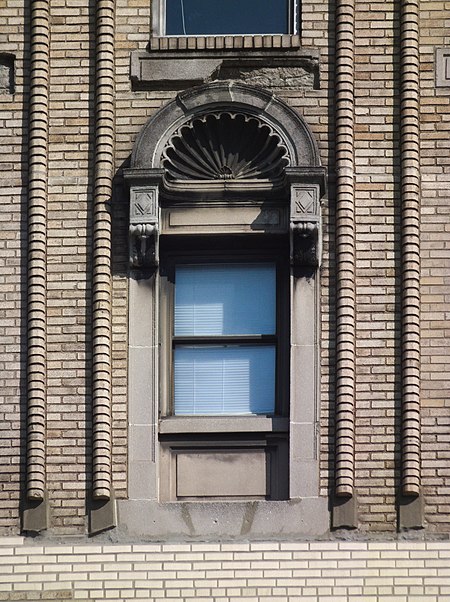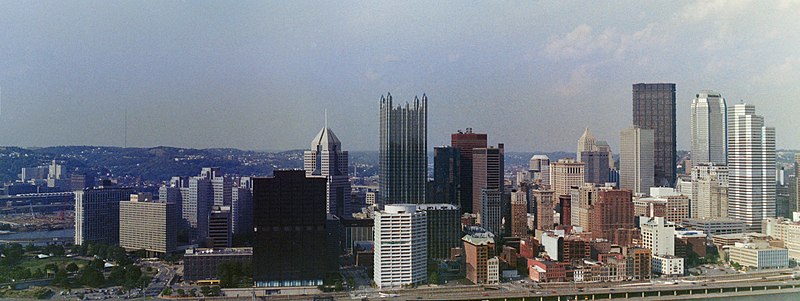
Improbable houses on the Slopes, with a view of Oakland in the background.

Schenley Farms is that quiet little enclave of grand houses in the Oakland university district. It is a museum of styles that were popular in the early twentieth century, and one of the most popular for grand houses was the Tudor style. Half-timbering (ostentatious beams with stucco between them), steep-pitched roofs, bays, and oriels (overhanging bays) are frequent marks of the style. Here’s a little gallery of Tudor houses from a short walk in the neighborhood.






A stained-glass window in an early-twentieth-century house in Beechview. Stained glass like this was especially popular between about 1890 and 1920, just when the streetcar suburbs that later became city neighborhoods were mushrooming. These windows are often stolen if the house is vacant for a while, but even so thousands still decorate houses all around the city.

The line between painted and unpainted on this long building is an artifact of its history. For most of its life this building was divided in two parts: the painted part was the convent, and the unpainted part the orphan asylum. More recently it has been a Franciscan retreat center known as the Burning Bush House of Prayer, whose somewhat archaic site tells us that the building was put up “in three stages, from 1887 to 1889.”


This exceptionally attractive industrial building is now—we really don’t have to say this, but we will anyway—loft apartments.

Uptown is a neighborhood in transition, and it still is not entirely clear what it will become. Will these rowhouses become valuable properties worth restoring? Or will they be knocked down for skyscraper apartments? Or will the development mania grind to a halt before it reaches this block? These two houses are in pretty good shape and worth preserving for their nearly intact fronts. Both have some fine woodwork. The one on the left has had some unfortunate renovation done to the dormer, but otherwise nothing bad has happened to it. It has newer windows, but in the right size and shape, and if you painted those aluminum frames they would be indistinguishable from the originals. The one on the right is even more perfectly intact. Note its proper Pittsburgh stair railing: in Pittsburgh, railings are a plumber’s art.


Father Pitt picked up a Fujifilm HS10 camera very cheaply, and here is a demonstration of its long range. The picture above and the picture below were taken standing in the same spot: the steps of the Mellon Institute across Fifth Avenue. The picture above is not a composite: the lens is wide enough for the whole building. (Of course the perspective has been adjusted, because old Pa Pitt wouldn’t let a picture go without doing that.)

A scallop-shell ornament over one of the windows in the upper floors. The long lens makes it easy to pick out interesting details, and the details on Webster Hall, designed by Henry Hornbostel, are worth picking out. It’s a kind of Art Deco Renaissance palace, built as luxury apartments, but soon changed into a hotel, and then back to luxury apartments again.





Here is an example of something you never see old Pa Pitt do. The usual jungle of utility cables infested this picture, and Father Pitt took them out. It’s not a perfect job, but it looks good from this distance. Having demonstrated that he is capable of doing it, Father Pitt may never do it again, but it does give us a good look at the front of an interesting old church.
Zion Evangelical Lutheran Church is the oldest open church in Lawrenceville: that is to say, it is the one that has been worshiping in the same building continuously for the longest time. This building was finished in 1874, and it has not changed much since then. In style it is a typical small Pittsburgh church of the time, with a shallow-pitched roof, the walls divided in sections by simple pilasters, and crenellations under the roofline. This is the Romanesque variant of that style. It could be made Gothic by swapping the rounded arches for pointed arches; it could be made classical by adding a few classical decorative elements.

The inscription reads “3.te Deutsche ev. Lutherische Zions Kirche” (“Third German Evangelical Lutheran Zion’s Church”). Someone has traced the date “1823” in white on the date stone in the gable. Father Pitt believes it is a mistake, although he would be happy to be corrected by anyone who knows better. The records indicate that the congregation was founded in 1868; the building opened in March of 1874, so the date 1873 would be plausible. Perhaps layers of paint made the date indistinct, and a painter misread the 7.

Here is the church with the utility cables. Father Pitt had the energy to remove them from one picture, but after that he had to lie down for a while. Since, however, these pictures are all licensed with a public-domain-equivalent CC0 license, nothing stops any motivated readers from adopting the photograph and spending the afternoon eliminating the cables—and that utility pole while they’re at it.

Two negatives stitched together; they had quite different lighting, but with some yanking and prodding in the GIMP, old Pa Pitt was able to make the seam nearly invisible. At the far left, we can see a big plot of cleared ground where PNC Park is about to be built.